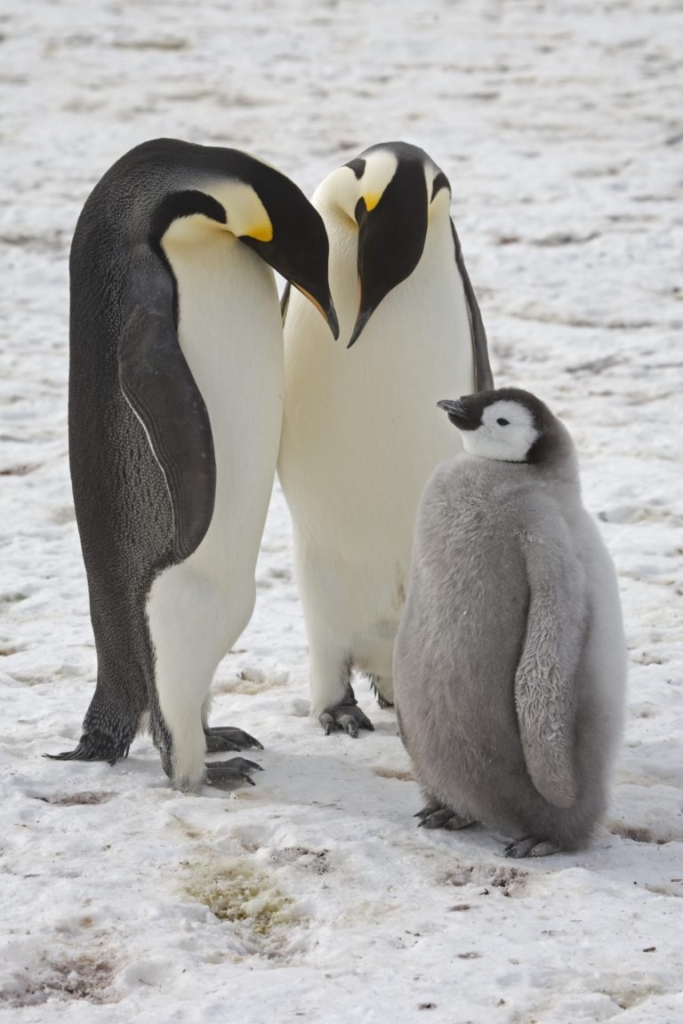“Catastrophic” breeding failure at one of world’s largest emperor penguin colonies after three consecutive years of sea-ice collapse – “Such a complete failure to breed successfully is unprecedented at this site”

25 April 2019 (BAS) – Emperor penguins at the Halley Bay colony in the Weddell Sea have failed to raise chicks for the last three years, scientists have discovered.
Researchers from British Antarctic Survey (BAS) studied very high resolution satellite imagery to reveal the unusual findings, published today (25 April 2019) in the journal Antarctic Science.
Until recently, the Halley Bay colony was the second largest in the world, with the number of breeding pairs varying each year between 14,000 – 25,000; around 5-9% of the global emperor penguin population.
The failure to raise chicks for three consecutive years is associated with changes in the local sea-ice conditions. Emperor penguins need stable sea-ice on which to breed, and this icy platform must last from April when the birds arrive, until December when their chicks fledge.
For the last 60 years the sea-ice conditions in the Halley Bay site have been stable and reliable. But in 2016, after a period of abnormally stormy weather, the sea-ice broke up in October, well before any emperor chicks would have fledged.
This pattern was repeated in 2017 and again in 2018 and led to the death of almost all the chicks at the site each season.
The colony at Halley Bay colony has now all but disappeared, whilst the nearby Dawson Lambton colony has markedly increased in size, indicating that many of the adult emperors have moved there, seeking better breeding grounds as environmental conditions have changed.
The re-location of many of the birds to a more stable breeding ground is encouraging, as until now it was not known whether the penguins would seek alternative sites in response to significant changes in their local environment.
Lead author and BAS remote-sensing specialist Dr Peter Fretwell said:
“We have been tracking the population of this, and other colonies in the region, for the last decade using very high resolution satellite imagery. These images have clearly shown the catastrophic breeding failure at this site over the last three years. Our specialised satellite image analysis can detect individuals and penguin huddles, so we can estimate the population based on the known density of the groups to give reliable estimate of colony size.”
BAS remote-sensing specialist Dr Peter Fretwell
BAS penguin expert and co-author Dr Phil Trathan, said: “It is impossible to say whether the changes in sea-ice conditions at Halley Bay are specifically related to climate change, but such a complete failure to breed successfully is unprecedented at this site.
“Even taking into account levels of ecological uncertainty, published models suggest that emperor penguins numbers are set to fall dramatically, losing 50-70% of their numbers before the end of this century as sea-ice conditions change as a result of climate change.”
By using satellite imagery to study the behaviour of this colony and its response to catastrophic sea-ice loss scientists will gain vital information about how this iconic species might cope with future environmental change.
“Emperors on thin ice: three years of breeding failure at Halley Bay”, by Peter T. Fretwell and Philip N. Trathan from the British Antarctic Survey is published in Antarctic Science. Read it here.
“Catastrophic” breeding failure at one of world’s largest emperor penguin colonies

ABSTRACT: Satellite imagery is used to show that the world’s second largest emperor penguin colony, at Halley Bay, has suffered three years of almost total breeding failure. Although, like all emperor colonies, there has been large inter-annual variability in the breeding success at this site, the prolonged period of failure is unprecedented in the historical record. The observed events followed the early breakup of the fast ice in the ice creeks that the birds habitually used for breeding. The initial breakup was associated with a particularly stormy period in September 2015, which corresponded with the strongest El Niño in over 60 years, strong winds, and a record low sea-ice year locally. Conditions have not recovered in the two years since. Meanwhile, during the same three-year period, the nearby Dawson-Lambton colony, 55 km to the south, has seen a more than tenfold increase in penguin numbers. The authors associate this with immigration from the birds previously breeding at Halley Bay. Studying this ‘tale of two cities’ provides valuable information relevant to modelling penguin movement under future climate change scenarios.
Emperors on thin ice: three years of breeding failure at Halley Bay